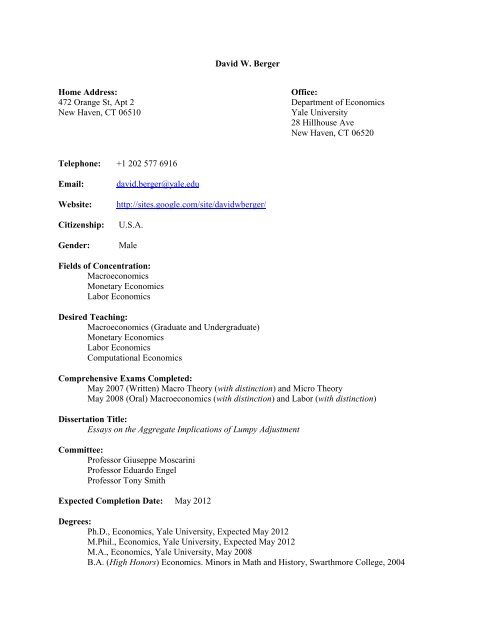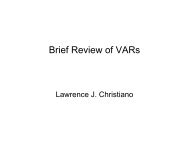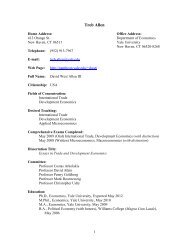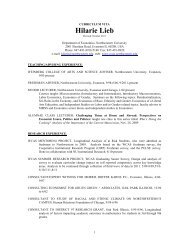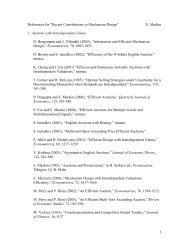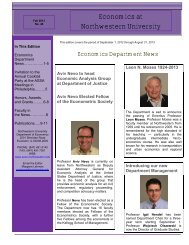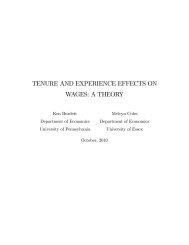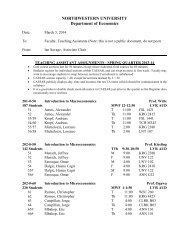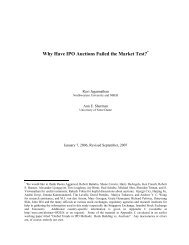David W. Berger Home Address: Office - Northwestern University
David W. Berger Home Address: Office - Northwestern University
David W. Berger Home Address: Office - Northwestern University
You also want an ePaper? Increase the reach of your titles
YUMPU automatically turns print PDFs into web optimized ePapers that Google loves.
<strong>David</strong> W. <strong>Berger</strong><br />
<strong>Home</strong> <strong>Address</strong>: <strong>Office</strong>:<br />
472 Orange St, Apt 2 Department of Economics<br />
New Haven, CT 06510 Yale <strong>University</strong><br />
28 Hillhouse Ave<br />
New Haven, CT 06520<br />
Telephone: +1 202 577 6916<br />
Email: david.berger@yale.edu<br />
Website: http://sites.google.com/site/davidwberger/<br />
Citizenship: U.S.A.<br />
Gender: Male<br />
Fields of Concentration:<br />
Macroeconomics<br />
Monetary Economics<br />
Labor Economics<br />
Desired Teaching:<br />
Macroeconomics (Graduate and Undergraduate)<br />
Monetary Economics<br />
Labor Economics<br />
Computational Economics<br />
Comprehensive Exams Completed:<br />
May 2007 (Written) Macro Theory (with distinction) and Micro Theory<br />
May 2008 (Oral) Macroeconomics (with distinction) and Labor (with distinction)<br />
Dissertation Title:<br />
Essays on the Aggregate Implications of Lumpy Adjustment<br />
Committee:<br />
Professor Giuseppe Moscarini<br />
Professor Eduardo Engel<br />
Professor Tony Smith<br />
Expected Completion Date: May 2012<br />
Degrees:<br />
Ph.D., Economics, Yale <strong>University</strong>, Expected May 2012<br />
M.Phil., Economics, Yale <strong>University</strong>, Expected May 2012<br />
M.A., Economics, Yale <strong>University</strong>, May 2008<br />
B.A. (High Honors) Economics. Minors in Math and History, Swarthmore College, 2004
Fellowships, Honors and Awards:<br />
Carl Arvid Anderson Fellowship, Cowles Foundation, 2010-2011<br />
NSF Graduate Research Fellowship, 2007-2012<br />
Raymond Powell Teaching Prize, Yale <strong>University</strong>, 2008-2009<br />
Dissertation Fellowship, Yale <strong>University</strong>, 2010-2011<br />
Doctoral Fellowship, Yale <strong>University</strong>, 2006-2010<br />
Phi Beta Kappa Honor Society, 2004<br />
Teaching Experience:<br />
Teaching Fellow: Econ 510a: General Economic Theory: Macroeconomics (Graduate), Fall 2008<br />
Teaching Assistant, Department of Economics, Swarthmore College, Fall 2003<br />
Work Experience:<br />
Visiting Researcher, Bureau of Labor Statistics: Spring 2005 – present<br />
Research Assistant, Professor Giuseppe Moscarini, Fall 2009 – present<br />
Research Assistant, Professor Eduardo Engel, May 2007 – 2009<br />
Research Assistant, Professor Ricardo Caballero, May 2007 – 2009<br />
Research Assistant, Federal Reserve Board of Governors, June 2004-July 2006<br />
Published Papers:<br />
“Order Flow and Exchange Rate Dynamics in EBS system Data (2008),” with S. Chernenko, A.<br />
Chaboud and J. Wright, Journal of International Economics, Vol. 75 Issue 1 pp. 93-109<br />
“What Drives Volatility Persistence in the FX Market,” with A. Chaboud and E. Hjmarrson<br />
(2009), Journal of Financial Economics, Vol 94, Issue 2 pp. 192-213<br />
Working Papers:<br />
“Countercyclical Restructuring and Jobless Recoveries” (November 2011), Job Market Paper<br />
“Dynamics of the U.S. Price Distribution” (August 2011) with Joseph Vavra<br />
“Consumption Dynamics During the Great Recession” (November 2011), with Joseph Vavra<br />
“Missing Aggregate Dynamics: On the Slow Convergence of Lumpy Adjustment Models”<br />
(August 2011) with Eduardo Engel and Ricardo Caballero)<br />
“Border Prices and Retail Prices” (May 2011), with J. Faust, J. Rogers and K. Steverson, revise<br />
and resubmit Journal of International Economics<br />
Work In Progress:<br />
“Firm Size, Employment Dynamics and the Business Cycle”<br />
Conferences:<br />
MOOD 2010: EIEF, Rome (July 2011)<br />
Cologne Macro Conference (July 2011)
References:<br />
Professor Giuseppe Moscarini Professor Eduardo Engel<br />
Yale <strong>University</strong> Yale <strong>University</strong><br />
Department of Economics Department of Economics<br />
PO Box 208269 PO Box 208269<br />
New Haven, CT 06520 New Haven, CT 06520<br />
Phone: (203) 432-3596 Phone: (203) 432-5595<br />
Email: giuseppe.moscarini@yale.edu Email: eduardo.engel@yale.edu<br />
Professor Tony Smith<br />
Yale <strong>University</strong><br />
Department of Economics<br />
PO Box 208269<br />
New Haven, CT 06520<br />
Phone: (203) 432-3583<br />
Email: tony.smith@yale.edu<br />
Research Statement<br />
My research interests span the fields of Macroeconomics, Labor Economics and International Trade and<br />
Finance, with a focus on business cycles. I am particularly interested in the way that microeconomic<br />
heterogeneity and lumpy adjustment interact to generate real, macroeconomic effects. My research is<br />
guided by economic theory and I investigate these questions by combining evidence from dynamic,<br />
quantitative models that are disciplined by micro data and more reduced form techniques.<br />
Countercyclical Restructuring and Jobless Recoveries (Job Market Paper)<br />
My job market paper investigates why the last three employment recoveries in the U.S. have been<br />
jobless. I argue that jobless recoveries result because firms are now more able to “restructure” by<br />
shedding their least productive workers during recessions. Firms enter recoveries “lean and mean”, more<br />
able to meet expanding demand without hiring additional workers. In contrast to previous explanations<br />
for jobless recoveries, my hypothesis is consistent with another, less well known fact: since the mid-<br />
1980s, average labor productivity (ALP) has become markedly less cyclical. This additional fact is<br />
important because the cyclicality of ALP declined at the same time as employment recoveries became<br />
markedly more jobless, which suggests a common cause for these two phenomena. In this paper, I<br />
formalize a single explanation for both facts.<br />
I develop a quantitative model where firms take advantage of recessions as an opportunity to<br />
streamline and restructure. In particular, I add worker heterogeneity, adjustment costs and the ability to<br />
selectively fire to a standard competitive industry model with endogenous entry and exit (Hopenhayn<br />
1992). The model captures the idea that firms grow "fat" during booms but then quickly "restructure"<br />
during recessions by laying off their unproductive workers. I call this mechanism "restructuring" because<br />
it formalizes the conventional wisdom that firms survive recessions by focusing on cost cutting and<br />
boosting productivity. I show that this model can quantitatively match both facts: it explains 54% of the<br />
decline in the procyclicality of ALP and can generate substantial jobless recoveries. Next, I explore<br />
whether the employment recovery in 2009 was jobless because the corresponding output recovery was<br />
anemic relative to previous recoveries. To do so, I examine what the employment recovery after Great<br />
Recession would have been had output growth been as strong as it was after the 1982 recession, which<br />
was a much more robust recovery. I find that the jobless recovery would have only been about two<br />
quarters in duration, about half of what we have observed.<br />
Finally, I discussed what changed in the 1980s that allowed firms to be more able to selectively
fire. I provide suggestive evidence that the structural change was the result of a large decline in union<br />
power in the 1980s. This led to a sharp reduction in the restrictions firms faced when adjusting<br />
employment, which lowered firing costs and made it easier for firms to fire selectively. I test this<br />
hypothesis using variation from U.S. states and industries and show that states and industries that had<br />
larger percentage declines in union coverage rates had larger declines in the in the cyclicality of ALP,<br />
consistent with my hypothesis.<br />
Consumption Dynamics During the Great Recession (With Joseph Vavra):<br />
Business cycle models typically abstract from the distinction between durable and non-durable<br />
consumption. However, in the 2007 recession, durable expenditures fell by three times as much as GDP<br />
while non-durable expenditures fell by slightly less than GDP. We show that simple extensions of<br />
business cycle models (both with and without complete markets) that assume frictionless durable<br />
adjustment are no more successful at matching the behavior of consumption, as they imply a decline in<br />
durable expenditures that is too large and a decline in non-durable expenditures that is too small, relative<br />
to the recession.<br />
Motivated by micro evidence, we introduce fixed costs of durable adjustment into the<br />
incomplete markets model and show that the model is able to match the behavior of consumption in the<br />
most recent recession. Fixed costs dampen the volatility of durable expenditures and amplify the volatility<br />
of non-durable expenditures, as a large fraction of households hold wealth in illiquid durables. In<br />
addition, the model implies non-linear dynamics that are in line with time-series data: durable<br />
expenditures respond more strongly to shocks during booms than during recessions. Finally, we provide<br />
additional evidence that supports our model: using micro panel data we show that households with a large<br />
fraction of wealth in durables are less able to insure against income shocks.<br />
.<br />
Dynamics of the U.S. Price Distribution (With Joseph Vavra)<br />
Price setting behavior determines the real effects of monetary policy. A long literature in<br />
macroeconomics uses higher moments of the cross-sectional distribution of price changes to distinguish<br />
between different price setting models. Almost all existing empirical evidence is based on highly<br />
aggregated data or small samples. Studies frequently contradict each other, making it difficult to identify<br />
the true empirical facts. In this paper, we shed new light on this literature by studying higher moments of<br />
the price change and their relationship to the broader business cycle using the monthly confidential micro<br />
data that the Bureau of Labor Statistics collects to create the Consumer Price Index.<br />
We document four new facts about the distribution of price changes in the United States: (1) The<br />
cross-sectional dispersion (second moment) of price changes is strongly countercyclical. This<br />
countercyclical dispersion holds both within and between sectors, as well as for price increases, decreases<br />
and the spread between the mean increase and decrease. These facts are consistent with the presence of<br />
second moment shocks as in Bloom (2009). (2) Price dispersion is positively correlated with the<br />
frequency of adjustment. (3) There is a U-Shaped relationship between price dispersion and inflation.<br />
(4) The skewness of price changes is moderately correlated with inflation but is acyclical. In contrast to<br />
previous research, we show that facts (3) and (4) are not useful for distinguishing between models of price<br />
setting behavior, but that facts (1) and (2) are.<br />
Missing Aggregate Dynamics: On the Slow Convergence of Lumpy Adjustment Models (with<br />
Eduardo Engel and Ricardo Caballero- In Progress)<br />
In most instances, the dynamic response of monetary and other policies to shocks is infrequent<br />
and lumpy. The same holds for the microeconomic response of some of the most important economic<br />
variables, such as investment, labor demand, and prices. We show that the standard practice of estimating<br />
the speed of adjustment of such variables with partial-adjustment ARMA procedures substantially
overestimates this speed. While aggregating across microeconomic units reduces the bias in many<br />
instances convergence is extremely slow. Because the bias rises with disaggregation, findings of<br />
microeconomic adjustment that is substantially faster than aggregate adjustment are generally suspect.<br />
We provide a methodology for overcoming the adjustment bias based on the innovative use of micro data.<br />
We demonstrate the effectiveness of our procedure using confidential pricing data from the BLS CPI<br />
Research Database. We show that in contrast to previous research (Boivin, Giannoni, and Mihov, 2009),<br />
we find little evidence that prices respond more quickly to sectoral shocks than to aggregate shocks.<br />
Ongoing Research<br />
I currently have two strands of ongoing work based on my job market paper. In the first, I<br />
investigate a more general notion of firm restructuring. In my JMP, I formalize restructuring as taking<br />
place solely within establishments. However, large firms have many margins of adjustment: they can shut<br />
down divisions, product lines or establishments (Bernard, Redding and Schott, 2010). Explicitly<br />
modeling these additional margins of adjustment may help explain why large firms shed proportionately<br />
more workers in recessions (Moscarini and Postel-Vinay, 2011). In the second, I test some establishment<br />
level implications of my model using the confidential, establishment level data from the BLS Business<br />
Employment Dynamics (BED) program.<br />
In ongoing work with Eduardo Engel and Joe Vavra, we assess the extent to which the<br />
transmission of aggregate and sectoral shocks to inflation varies across time using confidential price data<br />
from the CPI, IPP and PPI. Results from previous research projects suggest that there may be large scope<br />
for inflation dynamics to vary with the aggregate state of the economy. In particular, inflation responds<br />
more strongly to nominal shocks during recessions and times of high uncertainty. We investigate this in<br />
much more detail by decomposing the sources of these time varying dynamics and by exploring whether<br />
there are fundamental differences in the response to different types of shocks.


